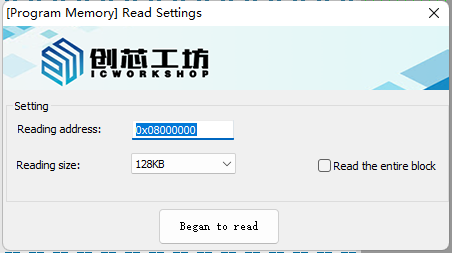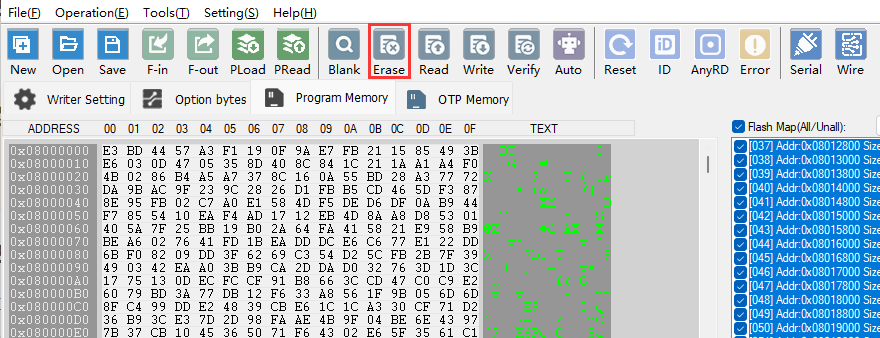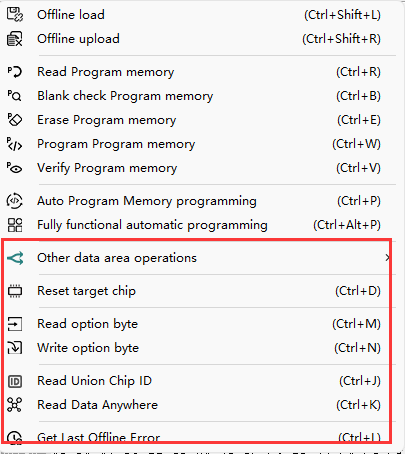3.2.4 Data R/W
PowerWriter® supports five operations: check null, read, erase, write, and verify for all data segments, mainstream data segments, including.
- Program Memory (Main Flash)
- EEPROM User data storage area
- OTP One Time User Programmable Storage Area (cannot be erased, can only be written to once)
Some chips contain other zones, such as Nuvoton include SPI zone, APROM, LDROM, DATA and other blocks.
In the operation of the data area needs to establish a concept, all the data area in the PowerWriter® on the same level, as well as the same method of processing, so the operation process is also highly similar to the following Program Memory as an example of the data area of the read and write method.
- The first step in the online operation must be to ensure that the target chip has been linked properly, please refer to the Online connection to the target chip。
- If the chip is read-protected, it must be unprotected first, see Option byte read/write。
3.2.4.1 Program Memory
Program Memory area support as shown:
- Read Program Memory.
- Check Program Memory empty.
- Erase Program Memory.
- Programming Program Memory.
- Verify Program Memory.
3.2.4.1.1 Read Program Memory
Click Read Program Memory in the menu to read the data into the buffer as shown below:

- Data can be exported to a disk file using the Export Data button on the toolbar.
- When exporting data, you can mark the start address and end address of the export in the buffer, so that you can freely export segments.
- The read data is stored in the buffer editor.
3.2.4.1.2 Check Program Memory
Check if the chip is empty by clicking the Empty Program Memory button in the menu, as shown in the figure:

- If the chip is null, there will be no dialogue box message, only log bar message, if it is not null, there will be a popup to read the first sector that is not null.
- Check empty chip is not necessarily all 0xFF, part of the chip characteristics of the reason, 0x00, also for the empty chip, depending on the chip erase the value of how much.
3.2.4.1.3 Erase Program Memory
Erase the chip by clicking the Erase Program Memory button in the menu as shown:

- If you want to erase a sector, please select the corresponding sector and use the erase check button to erase the sector.
- When erase fails, check for read protection or write protection.
3.2.4.1.4 Program code flash
Program the corresponding data area by clicking the Program Program Memory button in the menu, as shown in the figure:

- If there is an added file: the imported file will be written to the target chip, support multiple files, random data, etc.
- If no file is added: the current buffer is written to the target chip.
3.2.4.1.5 Verify Program Memory
Check if the chip is empty by clicking the Verify Program Memory button in the menu, as shown in the figure:

- If there are added files: the imported files will be verified, multiple files are supported.
- If no file is added: the current buffer is checked.
- Random data: random data will not be involved in the checksum!
3.2.4.2 Data export
Refer Chip Data Export Save the target chip data to a disk file.
3.2.4.3 Other areas (EEPROM, OTP, etc.)
The other data areas also support similar operations as Program Memory, support for reading, checking empty, erasing (OTP does not support erasing), writing, checking, and the operation entrance is shown in the other data area operations.
Other data area operations are a subset of Program Memory and are not yet done with multi-firmware support, all other features are provided.
3.2.4.4 Toolbar buttons
To read or write the target chip data, the conventional way is to use the menu entry, the advanced way is to use the shortcut keys, and the high level method is to use the toolbar quick entry as shown below:
From left to right:
- Check blank the current page.
- Erases the current page.
- Reads the current page.
- Programming the current page.
- Verify the current page.
To use, switch the tab to the corresponding page and execute the five buttons as above to quickly operate the current page online.
The current page refers to the main tab of the PowerWriter® client, as shown below:
3.2.4.5 Other online operations
Power Writer also offers other common online features such as:
- Reset the target chip.
- Read the CID.
- Operations such as reading data from any address.
All of these operations can be accessed through the menus or can be shortcut using the toolbar buttons.

3.2.4.6 Handling of programming failures
Refer to Online programming failure to get the processing method.